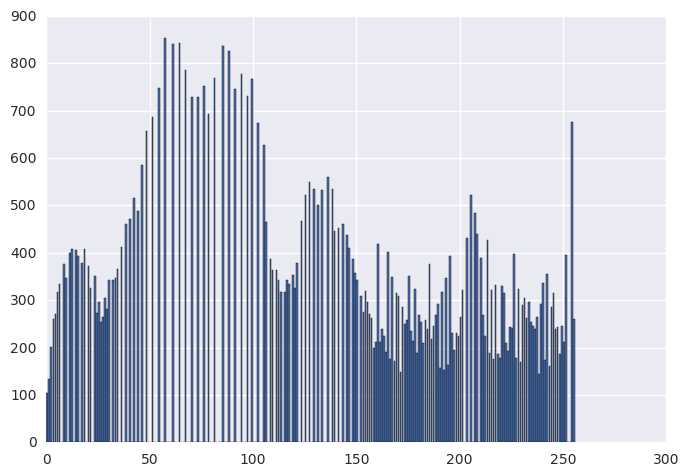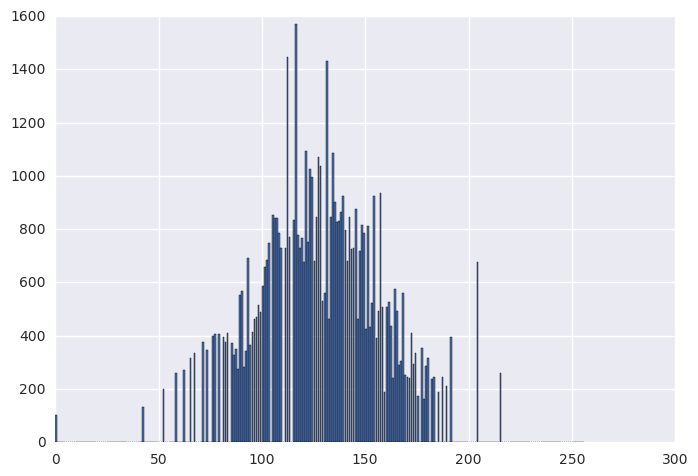Solution proposal - week 5
Based on the atomatic generation of this jupyter notebook.
Solutions to programming exersices week 5
INF2310, spring 2017
Histogram equalization
In this week’s exescise, we will show how to implement a histogram equalization, and apply it on some images.
% matplotlib inline
import cv2
import numpy as np
import matplotlib.pyplot as plt
import seaborn
This function takes a graylevel image and an integer specifying the number of gray levels in the result image. Thanks to Kristine for providing a proposal (I have only changed some variable names, added a method docstring, and returned the transform).
def histeq(img, num_gl):
"""Computes a histogram equalization transform of the input image.
Args:
img: MxN numpy array of int. Input image that is to be transformed.
num_gl: int. Number of graylevels in input image.
Returns:
trans_img: MxN numpy array of int. Histogram equalized image.
"""
N, M = img.shape
norm_hist = np.array([np.sum(img == g) for g in range(num_gl)])/(N*M)
cumul_hist = np.array([np.sum(norm_hist[:g+1]) for g in range(num_gl)])
transform = np.round((num_gl - 1)*cumul_hist).astype(int)
trans_img = transform[img]
return trans_img, transform
Task 3
Let us test our function on the test image
img = np.array([[1, 1, 1, 4, 4, 4, 4, 3],
[1, 1, 1, 2, 2, 3, 2, 2],
[1, 1, 1, 4, 4, 2, 4, 0],
[1, 1, 1, 2, 3, 3, 4, 0],
[1, 1, 1, 2, 1, 4, 4, 3],
[4, 1, 2, 1, 1, 1, 1, 1],
[4, 4, 4, 1, 1, 1, 1, 1],
[4, 2, 4, 3, 2, 4, 4, 0]])
trans_img, _ = histeq(img, 8)
print(trans_img)
[[3 3 3 7 7 7 7 5]
[3 3 3 4 4 5 4 4]
[3 3 3 7 7 4 7 0]
[3 3 3 4 5 5 7 0]
[3 3 3 4 3 7 7 5]
[7 3 4 3 3 3 3 3]
[7 7 7 3 3 3 3 3]
[7 4 7 5 4 7 7 0]]
orig_hist, _ = np.histogram(img, bins=8, range=(0, 8))
print(orig_hist)
plt.bar(range(0, 8), orig_hist)
[ 3 27 10 6 18 0 0 0]
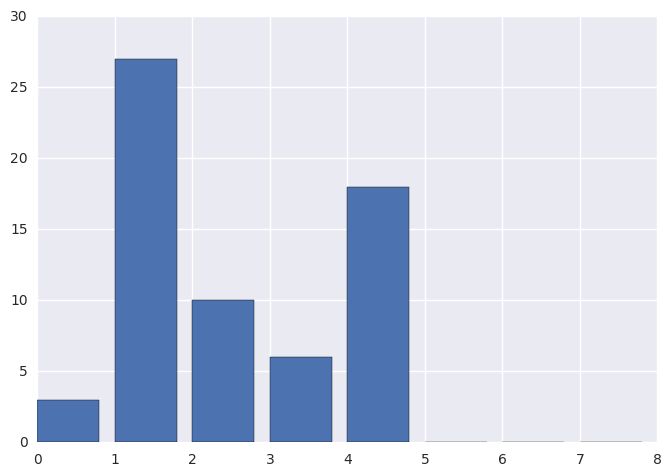
trans_hist, _ = np.histogram(trans_img, bins=8, range=(0, 8))
print(trans_hist)
plt.bar(range(0, 8), trans_hist)
[ 3 0 0 27 10 6 0 18]
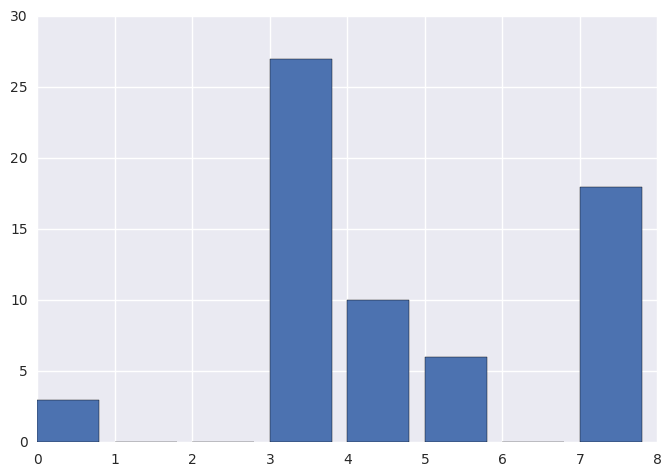
Task 5
# If you are going to compare this result to the one in the lecture slides,
# note that this image is not identical.
img = cv2.imread('../../assets/images/car.png', cv2.IMREAD_GRAYSCALE)
histeq_img, _ = histeq(img, 256)
plt.figure(0)
plt.imshow(img, cmap='gray')
plt.axis('off')
plt.figure(1)
plt.imshow(histeq_img, cmap='gray')
plt.axis('off')


orig_hist, _ = np.histogram(img, bins=256, range=(0, 256))
histeq_hist, _ = np.histogram(histeq_img, bins=256, range=(0, 256))
plt.figure(0)
plt.bar(range(0, 256), orig_hist)
plt.figure(1)
plt.bar(range(0, 256), histeq_hist)

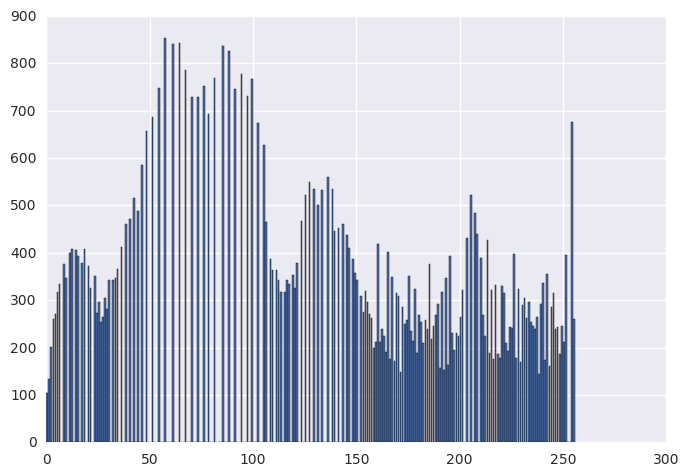
Task 8
In this task, we will implement a histogram matching transform. We will try to match the normal distribution, but whatever other appropriate distribution can be used.
Let us first compute the Gaussian pmf and cmf. This is not strictly necessary, and you could just as well use the methods from scipy (I will compare them below).
def gaussian(x, mu, sigma):
"""Compute the Gaussian probability mass function (pmf) and cumulative mass function (cmf)
Args:
x: 1D numpy array
mu: Mean value of distribution
sigma: Standard deviation of distribution
Returns:
pmf: 1D numpy array of same size as x. Gaussian probability mass function.
cmf: 1D numpy array of same size as x. Gaussian cumulative mass function.
"""
# We do not compute the pmf
#
# pmf = 1 / np.sqrt(2*np.pi*sigma**2)*np.exp(-(x - mu)**2 / (2*sigma**2))
#
# directly. Instead we compute the logarithm, and then take the exp of the logarithm.
# This mitigates overflow errors (since the exponential tends to be quite large for
# large arguments (when x is large)).
log_pmf = -1/2*np.log(2*np.pi*sigma**2) - (x - mu)**2 / (2 * sigma**2)
pmf = np.exp(log_pmf)
cmf = np.array([np.sum(pmf[:i+1]*(x[1] - x[0])) for i, _ in enumerate(x)]) # NB step size is assumed uniform over x
return pmf, cmf
# Let us test the implementation
from scipy.stats import norm
x = np.linspace(-4, 4, 1000)
mu = 0
sigma = 1
pmf, cmf = gaussian(x, mu, sigma)
plt.figure(0)
plt.plot(x, pmf, 'r')
plt.plot(x, cmf, 'b')
# Ensure that our implementation makes sense
print(np.linalg.norm(pmf - norm.pdf(x, mu, sigma)))
print(np.linalg.norm(cmf - norm.cdf(x, mu, sigma)))
6.25577620616e-16
0.0231211616533

def match_hist_to_gauss(img, num_gl, mu, sigma):
"""Performs a histogram matching on the input image.
Args:
img: MxN numpy array of int. Input image that is to be transformed.
num_gl: int. Number of graylevels in input image.
mu: float. Desired mean of the matched normal distribution.
sigma: float. Desired standard deviation of the matched normal distribution.
Returns:
trans_img: MxN numpy array of int. Histogram transformed image.
"""
# Get the histogram-equalized image, and the transform from the function we made above
histeq_img, histeq_trans = histeq(img, num_gl)
# Get the desired probability mass function and cumulative mass function
# (in this case from the Gaussian distribution). It is rather important
# that the length of the pmf and cmf is of size num_gl such that there
# is one value for each graylevel
x = np.linspace(0, num_gl-1, num_gl)
norm_pmf, norm_cmf = gaussian(x, mu, sigma)
# Create a new mapping from the histeq to the wanted image
norm_map = np.round((num_gl - 1)*norm_cmf)
inv_norm_map = np.array([int(np.argmin(np.abs(norm_map - histeq_trans[g]))) for g in range(num_gl)])
# More verbose version of the list comprehension above (note that np.argmin returns the smallest
# index if there are more than one):
# inv_norm_map = np.zeros(num_gl)
#for g in range(num_gl):
# closest_index = int(np.argmin(np.abs(norm_map - histeq_trans[g])))
# inv_norm_map[g] = closest_index
# Create a new image based on this transform
trans_img = inv_norm_map[histeq_img.astype(np.uint8)]
trans_img = np.zeros_like(histeq_img)
for ind, val in enumerate(histeq_trans):
trans_img[histeq_img==val] = inv_norm_map[ind]
# Scale it back to original value range (assumed here to be [0, 255])
#return 255*(np.max(trans_img) - trans_img)/(np.max(trans_img) - np.min(trans_img))
return trans_img
Let us test it with the car image from earlier
mu = 128
sigma = 30
num_gl = 256
norm_img = match_hist_to_gauss(img, num_gl, mu, sigma)
# Compare images
plt.figure(0)
plt.imshow(img, cmap='gray')
plt.axis('off')
plt.figure(1)
plt.imshow(histeq_img, cmap='gray')
plt.axis('off')
plt.figure(2)
plt.imshow(norm_img, cmap='gray')
plt.axis('off')

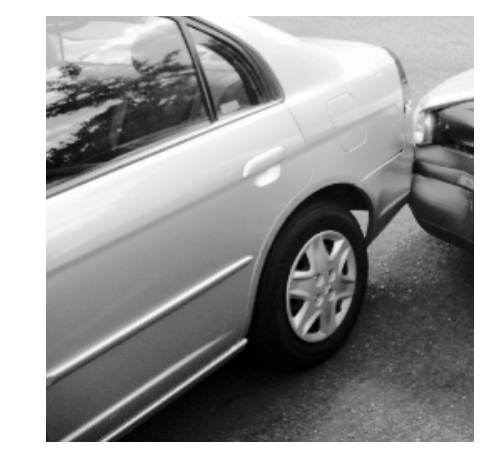
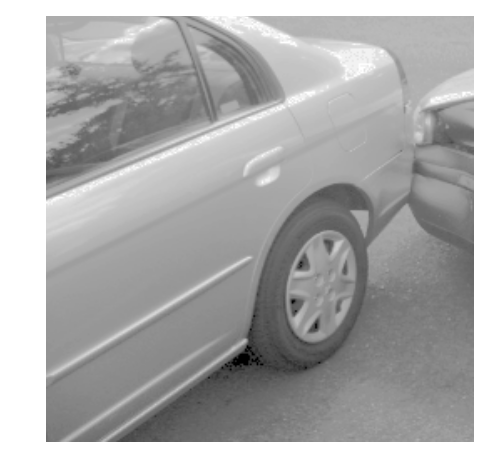
# Compare histograms
orig_hist, _ = np.histogram(img, bins=256, range=(0, 256))
norm_hist, _ = np.histogram(norm_img, bins=256, range=(0, 256))
plt.figure(0)
plt.bar(range(0, 256), orig_hist)
plt.figure(1)
plt.bar(range(0, 256), histeq_hist)
plt.figure(2)
plt.bar(range(0, 256), norm_hist)

